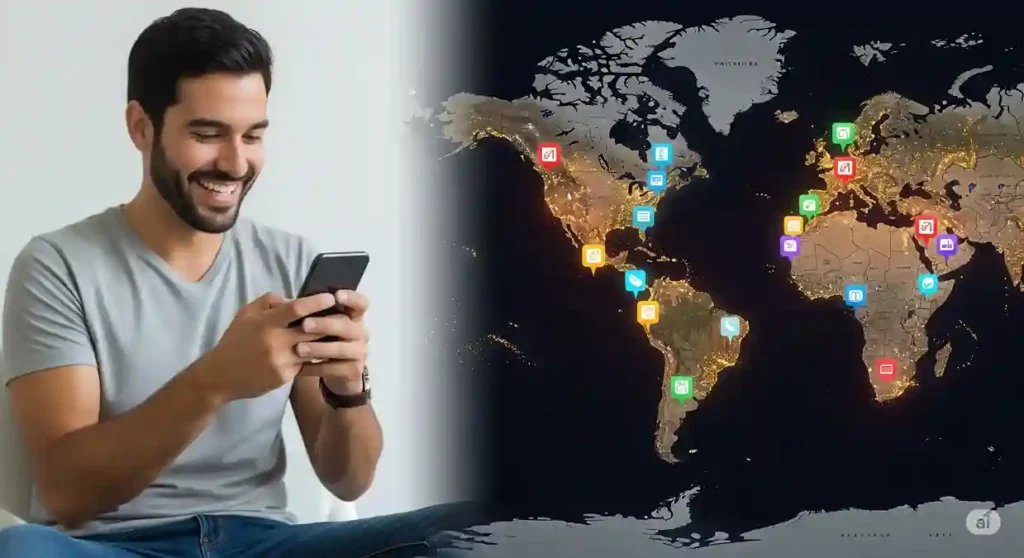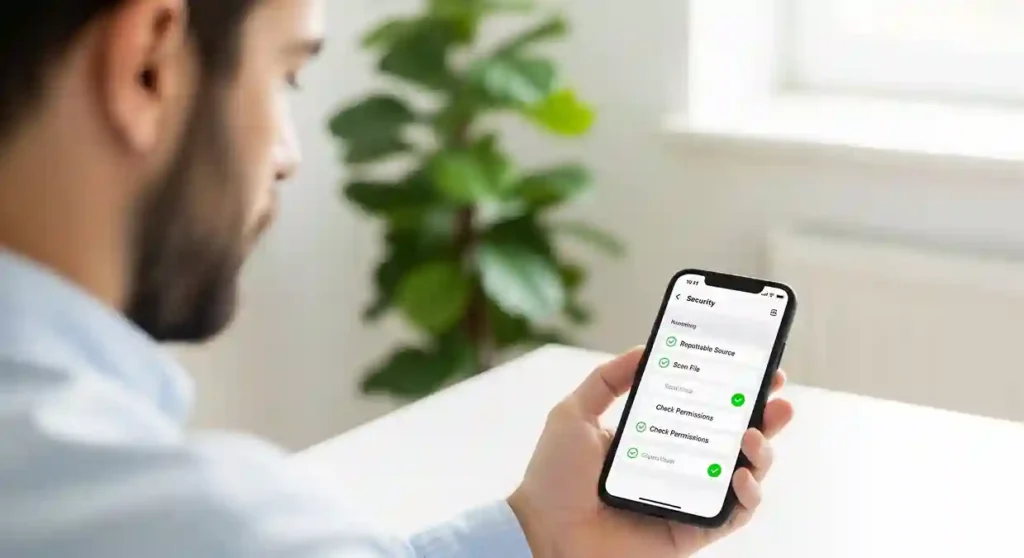In the vast and ever-expanding universe of Android applications, the Google Play Store stands as the official, curated, and fortified marketplace. But what happens if the app you need isn’t there? This leads many users to a critical question: Is it safe to download an apk from a third-party website? The immediate and most responsible answer is that “ it is an activity laden with significant risk. It’s a calculated gamble. While the potential rewards—accessing apps you otherwise couldn’t—are tempting, the dangers are very real and can have lasting consequences for your digital security and privacy” .
This comprehensive guide will serve as your detailed manual for understanding this complex issue. We will thoroughly explore why a person might choose to download an apk from a third-party website, a process technically known as “sideloading.” More importantly, we’ll dive deep into the specific threats you expose yourself to and provide a robust framework of best practices. Following these guidelines is crucial if you decide the benefits outweigh the risks of choosing to download an apk from a third-party website. For many, the ability to download an apk from a third-party website represents a level of freedom and customization that is core to the Android experience, but this freedom is not without its price.
Why People Choose to Download an APK from a Third-Party Website

The Google Play Store is a meticulously managed “walled garden,” designed for maximum security and ease of use. However, sometimes the most interesting plants grow outside the walls. Users have several compelling reasons to venture out and download an apk from a third-party website.
Gaining Access to Geo-Restricted Applications
One of the most common drivers for sideloading is geographic restriction. A developer might launch an app, a game, or a streaming service exclusively in their home country for a testing phase or due to licensing agreements. For instance, a banking app for an international bank might only be available in its country of origin, creating a headache for an expat living abroad. Similarly, a popular new social media or gaming app might launch in North America months before it’s available in Europe or Asia. When waiting is not an option, the only viable solution is to find and download an apk from a third-party website.
Securing Early Access to App Updates
App developers rarely release updates to their entire user base simultaneously. They use a “staged rollout” system, pushing the update to a small percentage of users first (e.g., 1%, then 5%, then 20%) to monitor for any critical bugs before a full release. While this is a sensible practice for developers, it can be frustrating for enthusiasts who want the latest features and security patches immediately. These tech-savvy users will often turn to trusted third-party repositories where the latest APK file is available for immediate download, long before the update officially hits their device through the Play Store.
Reverting to Older Versions of an App
“If it ain’t broke, don’t fix it” is a sentiment many users share, especially after a particularly bad app update. Sometimes, a developer will release a new version that removes a beloved feature, introduces a clunky user interface, or is simply plagued with performance issues. A classic example is when a social media app changes its layout, much to the user base’s chagrin. In these situations, the only recourse is to uninstall the current version and find an older, more stable one. The Play Store does not allow for downgrading, so users must download an apk from a third-party website to get the specific version they want.
Bypassing App Store Policies and Restrictions
Google has a strict set of developer policies for apps allowed on the Play Store. These policies prohibit apps that facilitate copyright infringement (like many YouTube video downloaders), apps that modify other apps in unauthorized ways, or apps that pose potential security risks (like certain advanced system tools). Furthermore, some perfectly legitimate apps, such as powerful game emulators or alternative app stores, are not permitted. For users who want these functionalities, the only path is to download an apk from a third-party website.
Discovering the World of Open-Source (FOSS)
Beyond the mainstream, there is a thriving community of developers dedicated to creating Free and Open-Source Software (FOSS). These apps are built with transparency, privacy, and user control in mind. Many of these excellent FOSS apps are not listed on the Google Play Store by choice. Instead, they are hosted on dedicated repositories like F-Droid. To access this entire ecosystem of privacy-respecting browsers, ad-blockers, and utilities, a user must be willing and able to download an apk from a third-party website.
The Terrifying Dangers of Downloading an APK from a Third-Party Website

For every legitimate reason to sideload, there is a corresponding danger. When you download an apk from a third-party website, you are stepping outside of Google’s protective embrace and into a digital wild west. You are bypassing the multiple layers of security, including Google Play Protect, which scans billions of apps daily to keep users safe. Here are the specific threats you face.
The Plague of Malware and Viruses
This is, without a doubt, the single greatest danger. Malicious actors are experts at taking legitimate apps, injecting them with malicious code, and uploading them to unofficial sources. When an unsuspecting user installs the tainted APK, they are effectively opening the door to a host of threats. This is the primary risk of deciding to download an apk from a third-party website.
Ransomware
Imagine all your precious photos, videos, and documents being encrypted and held hostage. Ransomware on mobile devices can lock your files or your entire device, demanding payment (usually in cryptocurrency) for their release.
Spyware and Keyloggers
This insidious type of malware runs silently in the background, monitoring your every move. It can record your keystrokes to steal login credentials for your bank, social media, and email accounts. It can access your camera and microphone, turning your phone into a spy device in your pocket.
Adware
While less destructive, aggressive adware can make your phone nearly unusable. It can constantly bombard you with pop-up ads, inject ads into your web browser, and create phantom shortcuts on your home screen, all while draining your battery and data.
A trojan is malware disguised as a legitimate application. You might think you’re downloading a popular game, but in reality, you’re installing a program that could be stealing your contact list, sending premium-rate SMS messages, or using your phone’s processing power to mine cryptocurrency.
Unpatched Security Vulnerabilities
Think of a security vulnerability as an unlocked window on your house. Apps from the Play Store receive regular updates that not only add features but also “patch” these vulnerabilities, effectively locking the window. When you download an apk from a third-party website, you are often stuck with that specific version. You will not receive automatic security updates, leaving that window permanently unlocked for hackers to exploit known flaws in the app’s code.
Lack of Official Support and Updates
Beyond security patches, you miss out on everything else. If a feature breaks after an Android OS update, you have no official support channel to turn to. You won’t receive new features, performance improvements, or bug fixes. You are left with a static, aging piece of software that will likely become less functional over time.
Severe Privacy Concerns
Apps on the Play Store are required to have a privacy policy and be transparent about the data they collect. This is not always the case in the unregulated world of third-party APKs. A malicious app could request an alarming number of permissions, gaining access to your location, contacts, SMS messages, and storage. This data can be harvested and sold to data brokers, used for identity theft, or exploited for targeted phishing attacks. The potential for privacy violation is immense when you download an apk from a third-party website.
How to Safely Download an APK from a Third-Party Website: A Harm-Reduction Guide

If you have weighed the pros and cons and still determine that you must download an apk from a third-party website, you cannot proceed casually. You must adopt the mindset of a security professional. The following steps are not optional; they are essential for protecting yourself.
Vet Your Sources: Not All Websites are Created Equal
This is the most critical step. Do not simply search on Google and download from the first link you see. Stick to highly reputable and long-standing APK repositories.
- APKMirror: Widely regarded as the gold standard. It is run by the same team behind the popular Android Police blog. They verify the cryptographic signatures of all uploaded apps to ensure they are the same as the ones from the Play Store and have not been tampered with.
- APKPure: Another popular and generally trusted source that has its own security verification processes in place.
- F-Droid: As mentioned earlier, this is the go-to repository for free and open-source software. Its entire model is built on transparency and security.
Scan Everything Before and After Installation
Trust, but verify. Even when downloading from a reputable source, a second opinion is always a good idea.
- Use VirusTotal: Before you even attempt to install the APK file, upload it to a website called VirusTotal. This free service will scan the file with over 70 different antivirus engines, giving you a comprehensive security report.
- Enable Google Play Protect: Ensure this feature is enabled on your device (Settings > Security > Google Play Protect). It will scan apps during installation, even those from third-party sources, and periodically scan your device for harmful apps.
- Use a Mobile Antivirus: A top-tier mobile security app from a brand like Bitdefender, Norton, or Malwarebytes provides an essential real-time layer of protection.
Become a Permissions Detective
When you install the app, Android will show you a list of permissions it requires. Do not just mindlessly click “Accept.” Read every single permission and ask yourself, “Does this app really need this to function?” If a simple calculator app is asking for access to your contacts, camera, and location, that is a massive red flag. Deny unnecessary permissions. If the app refuses to run without them, delete it immediately.
Maintain Impeccable Digital Hygiene
Your device’s overall security posture is critical. Keep your Android operating system up to date with the latest security patches from your manufacturer. Regularly review the apps installed on your phone and uninstall anything you no longer use or trust.
Conclusion: Is it Worth the Risk to Download an APK from a Third-Party Website?

Returning to our core question, the answer remains a nuanced one. To download an apk from a third-party website is to consciously trade the iron-clad security of the Google Play Store for greater freedom and access. It is not an activity for the faint of heart or the technically inexperienced. For the average user, the risk of downloading a malware-infected application that could compromise your financial and personal data is simply too high. For them, the safest path is to remain within the walls of the Play Store.
However, for the power user, the enthusiast, or the individual with a specific, unmet need, sideloading can be a powerful tool. But it must be treated with the utmost respect and caution. It requires diligence, a healthy dose of skepticism, and a strict adherence to the safety protocols outlined above. Every time you download an apk from a third-party website, you are personally taking on the role of your device’s security guard. You must be prepared for that responsibility. If you are not, the potential cost is far greater than the benefit of any single application.






